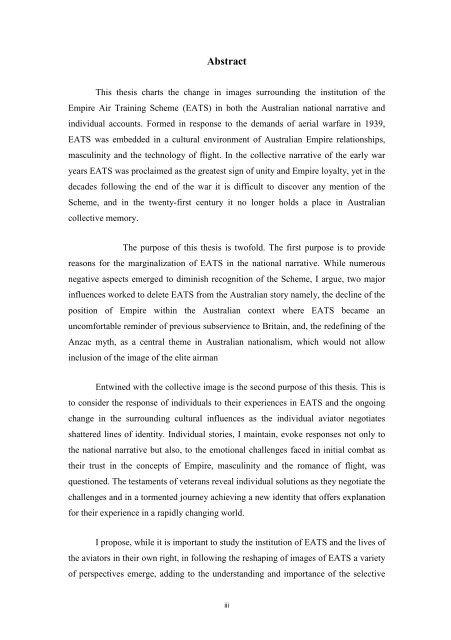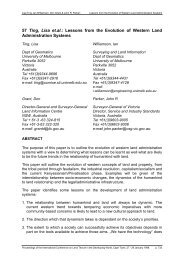- Page 1: The Empire Air Training Scheme: Ide
- Page 5 and 6: DeclarationThis is to certify that:
- Page 7 and 8: AcknowledgementsMy first expression
- Page 9: List of AbbreviationsABCAWMAIFBCATP
- Page 12 and 13: Introduction: Evolution of the Imag
- Page 14 and 15: memoirs in more recent years, these
- Page 16 and 17: the Mediterranean, Burma, South Eas
- Page 18 and 19: that are used to explore the change
- Page 20 and 21: identity. Scholars have established
- Page 22 and 23: In this area there is a paucity of
- Page 24 and 25: supported by a vast array of litera
- Page 26 and 27: source. 55 Scholars have now gone b
- Page 28 and 29: Memorial. The immediacy of such res
- Page 30 and 31: Chapter OutlineThere are several th
- Page 32 and 33: expressions of despair and disillus
- Page 34: changing cultural values. Once agai
- Page 37 and 38: transcendent calling. 4 In the age
- Page 39 and 40: The neglect of British politicians
- Page 41 and 42: Australian government, reflected in
- Page 43 and 44: program to modernize its air compon
- Page 45 and 46: measures and economic pressure, to
- Page 47 and 48: was linked directly to the aviator
- Page 49 and 50: Colonel Mark Wells, an experienced
- Page 51 and 52: examination of this theme emerges t
- Page 54 and 55:
CHAPTER 2This is a Man’s Job: Sed
- Page 56 and 57:
of recruits came from reviewing let
- Page 58 and 59:
MasculinityRepresentations of mascu
- Page 60 and 61:
fly it would pay you to travel to p
- Page 62 and 63:
Production of the ImageMilitary ins
- Page 64 and 65:
The media hailed the announcement o
- Page 66 and 67:
official campaign to recruit prospe
- Page 68 and 69:
was often enlisted in bouts against
- Page 70 and 71:
strong in White’s representation
- Page 72 and 73:
Diaries and LettersThe letters and
- Page 74 and 75:
The diary also provided a place for
- Page 76 and 77:
wealth of information and observati
- Page 78 and 79:
he reflected on the role of the air
- Page 80 and 81:
defined hegemonic male. 95 This doe
- Page 82 and 83:
A final comment highlights the ambi
- Page 84 and 85:
to question the authorities in thei
- Page 86 and 87:
This chapter examines the reactions
- Page 88 and 89:
governed by public codes of conduct
- Page 90 and 91:
and illustrate the various response
- Page 92 and 93:
us.’ 19 Another horrifically conf
- Page 94 and 95:
The diary of Geoffrey Berglund, who
- Page 96 and 97:
The sense of disbelief and shock re
- Page 98 and 99:
of Australian airmen. The depiction
- Page 100 and 101:
Mythologising the Air WarriorStrivi
- Page 102 and 103:
his wall, and it inspired him durin
- Page 104 and 105:
young Australian men who with valia
- Page 106 and 107:
called the ‘popular pleasure cult
- Page 108 and 109:
December 15 1942. 85 The poems, in
- Page 110 and 111:
Figure 14 Rear Gunner in a Halifax
- Page 112:
The intense sense of disillusionmen
- Page 115 and 116:
The purpose of this chapter is firs
- Page 117 and 118:
On his repatriation, Jo Fewster’s
- Page 119 and 120:
Middle East and not wanting to come
- Page 121 and 122:
administrative and organizational a
- Page 123 and 124:
crews are more often than not men o
- Page 125 and 126:
government which made the decisions
- Page 127 and 128:
images of all services. The 1946 ve
- Page 129 and 130:
In half an hour that little flame o
- Page 131 and 132:
Identifying the specific role of Au
- Page 133 and 134:
claimed independence from British s
- Page 135 and 136:
efused to talk or answer questions.
- Page 137 and 138:
the warrior heroes. Others have pur
- Page 139 and 140:
Kokoda trail, the public image of t
- Page 141 and 142:
national identity, images in both c
- Page 143 and 144:
instigation, establishing cooperati
- Page 145 and 146:
espected institution. 21 BCATP has,
- Page 147 and 148:
political mood and what has been te
- Page 149 and 150:
exhibition of G for George, the Lan
- Page 151 and 152:
of the Australian men and women who
- Page 153 and 154:
Figure 21 BCATP Memorial Gates at 8
- Page 155 and 156:
Australia’s ambiguous progression
- Page 157 and 158:
engineering to break the ties with
- Page 159 and 160:
Warriors’ and ‘Masters of the A
- Page 161 and 162:
period of fifteen years, it is poss
- Page 163 and 164:
The images in Wings of the Storm co
- Page 165 and 166:
series, The Valour and the Horror,
- Page 167 and 168:
which extolled the centrality of Au
- Page 169 and 170:
population. 113 The aura of elitism
- Page 171 and 172:
Other veteran organizations have be
- Page 173 and 174:
influence the way he described the
- Page 175 and 176:
forever, much less believed that Au
- Page 177 and 178:
talk about Top Gun, I was somewhat
- Page 179 and 180:
one else. Yet ‘as the years pass
- Page 181 and 182:
I’m concerned Nazism, Fascism and
- Page 183 and 184:
We were loaded onto a truck and rep
- Page 185 and 186:
It was so incredibly well run. It m
- Page 187 and 188:
And for years each government used
- Page 189 and 190:
statement suggested some explanatio
- Page 191 and 192:
suited their national interests. 53
- Page 193 and 194:
probably four or five Canadians, on
- Page 195 and 196:
Anyway, that’s one of the things
- Page 197 and 198:
ConclusionThe hypothetical question
- Page 199 and 200:
conflicts. 7 However, in aerial com
- Page 201 and 202:
confrontation that were completely
- Page 203 and 204:
a member of the Pathfinder Force. 2
- Page 205 and 206:
of real horror of war and no concep
- Page 207 and 208:
Medical ConceptsThe origins of mili
- Page 209 and 210:
maintained certain ‘weaklings’
- Page 211 and 212:
not. One veteran recalled that the
- Page 213 and 214:
what to do.’ He finally disclosed
- Page 215 and 216:
ask that question.’ 85 The emotio
- Page 217 and 218:
so much that we could see the bomb
- Page 219 and 220:
Dresden but Dresden was destroyed a
- Page 221 and 222:
then that refer to the sort of stro
- Page 223 and 224:
Two life journals were given to me
- Page 225 and 226:
War Memorial, who was a student of
- Page 228 and 229:
CHAPTER 8Reinventing The ImageHow q
- Page 230 and 231:
training, requiring both higher edu
- Page 232 and 233:
narrative. 10 By initiating the int
- Page 234 and 235:
Bobby Gibbes, awarded both the DFC
- Page 236 and 237:
commemoration, involved incorporati
- Page 238 and 239:
Dunstan recorded that his early tra
- Page 240 and 241:
In cultural tradition, war had been
- Page 242 and 243:
at Gallipoli of the Australian team
- Page 244 and 245:
saw Paul Robeson play Othello in Lo
- Page 246 and 247:
anything like as great if it had no
- Page 248 and 249:
that he chose not to march on Anzac
- Page 250 and 251:
‘unconquerable spirit’ from whi
- Page 252 and 253:
causing the Australian population t
- Page 254 and 255:
I remember writing once that I cons
- Page 256 and 257:
CONCLUSIONThe ‘I’ now and the
- Page 258 and 259:
Following the transformation of the
- Page 260 and 261:
veterans, beginning with those of D
- Page 262 and 263:
BIBLIOGRAPHYPrimary SourcesINTERVIE
- Page 264 and 265:
Bobby Gibbes AWM S0938Ken Gray AWM
- Page 266 and 267:
Menzies R.G. Empire Air Force Austr
- Page 268 and 269:
Centenary of Federation, the series
- Page 270 and 271:
Hillary, Richard. The Last Enemy Lo
- Page 272 and 273:
Secondary SourcesBOOKS AND ARTICLES
- Page 274 and 275:
Binneveld, Hans. From Shell Shock t
- Page 276 and 277:
Confino, Alon. ‘Collective Memory
- Page 278 and 279:
Darian-Smith, K. ‘Challenging His
- Page 280 and 281:
Freud, Sigmund. Beyond the Pleasure
- Page 282 and 283:
Herrington, John. Air War Against G
- Page 284 and 285:
Gerster, Robin. Big Noting: The her
- Page 286 and 287:
Kundera, Milan. The Book of Laughte
- Page 288 and 289:
McGibbon, Ian. New Zealand and the
- Page 290 and 291:
Newton Dennis. A Few of the Few. Au
- Page 292 and 293:
Ricoeur, Paul. Memory, History and
- Page 294 and 295:
Schreuder Deryck and Stuart Ward, e
- Page 296 and 297:
Veitch, Michael. Fly. Melbourne: Vi
- Page 298 and 299:
Winter, Jay. Sites of Memory, Sites
- Page 300 and 301:
Smith, Neil. History of 3 squadron
















